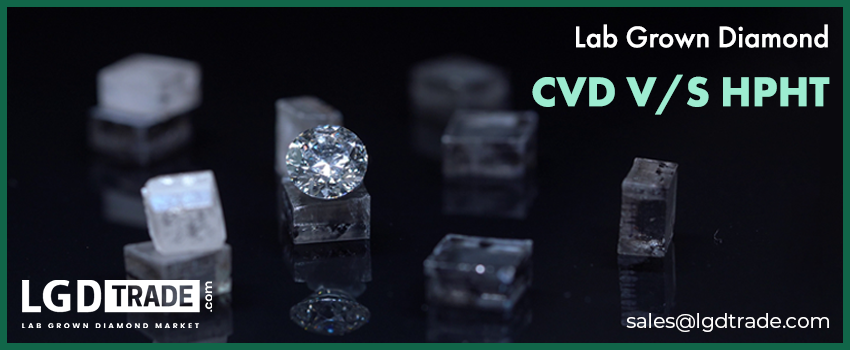
There are two ways to make lab-grown diamonds : HPHT (high pressure, high temperature) or chemical vapor deposition (CVD) (CVD). It’s critical to know the distinctions between HPHT and CVD diamonds and how they impact diamond quality while creating synthetic diamonds using both techniques. Diamonds that have been subjected to high pressure and high temperature are known as HPHT diamonds. Deep down, under circumstances of tremendous pressure and heat, natural diamond crystals were created. As a result, high pressure and high temperature were the first and oldest techniques for growing synthetic diamonds (HPHT).
HPHT diamonds may be produced using three different techniques: the belt press, the cubic press, and the split-sphere press. High pressure and high temperature are the two conditions required for diamond development (over 1.5 million pounds of pressure per square inch and above 1400°C). A diamond seed is placed in carbon, the element from which all diamonds are produced, and subjected to tremendous pressure and heat to begin the process. Carbon melts and forms a diamond around the seed when these circumstances are met. General Electric’s belt press produced the first repeatable HPHT lab-grown diamond on December 16, 1954. Because the diamond was so tiny and incorporated, it couldn’t be used to make jewelry. However, even today, the vast majority of synthetic diamonds created are not of gem grade. For industrial usage, they’re made with high-quality features like hardness and heat conductivity in mind.
HPHT technology has advanced in recent years thanks to the popularity of the belt press, and new models such as the cubic and split-sphere press have appeared. With them, it was possible to make bigger gem-quality diamonds while yet maintaining the same efficiency. Because they are exposed to nitrogen while developing, diamonds grown via the HPHT method tend to be tan or yellow. Due to the metals utilized during the development process and occasionally entering the diamond crystal, HPHT diamonds frequently have iron, nickel, and cobalt inclusions. Because natural diamonds seldom include metals during their creation, these metallic inclusions can assist specialists in identifying lab-grown diamonds.
Precisely What Is A Chemical Vapour Deposition Diamond?
A more modern diamond-growing technology, Chemical Vapour Deposition (CVD), was developed in the 1980s and used a hydrocarbon gas combination to produce a gemstone similar to how diamonds originate in interstellar gas clouds. A diamond crystal wafer is heated to 800°C in a vacuum chamber during the CVD process. A carbon-rich gas, such as methane, is then introduced into the chamber and ionized into plasma by lasers, microwaves, or other means. It is possible to create a diamond crystal atom by atom by layer by using this process.
The gas molecules are ionized, and pure carbon is deposited on the crystal’s wafer (which is generally made of HPHT synthetic diamond). There are a few advantages to using CVD diamond growth over HPHT diamond growing. It’s not necessary to use high pressure or temperatures exceeding 1400 °C. Therefore this is a considerably less expensive method. Colorless diamonds can be created using the CVD technique since there is no color zoning. CVD diamonds are devoid of metal inclusions, but their development process typically leaves them with graphite or other mineral inclusions.
HPHT Vs. CVD Diamonds:
There is a significant variation in the morphology of HPHT versus CVD diamonds. Unlike CVD diamonds, which grow cubic and have 14 development directions, HPHT diamonds grow cuboctahedron-shaped, with a cuboctahedron form. Natural diamonds, on the other hand, form in an octahedron and grow in 8 different directions. Mined diamonds and synthetic diamonds may be distinguished primarily based on their development patterns. Diamonds created with HPHT tend to be yellow or brown, but diamonds created using CVD have always been colorless. Today, both methods can create a colorless, perfect diamond; the only variation is morphological structure. Not to add, there is a lot of conflicting information out there regarding the best way to grow diamonds. What’s going on behind the scenes, though, is that each corporation is fighting for its interests. Customers of a CVD firm will be advised to steer clear of HPHT diamonds, and the reverse is also true.
There was deliberate doping of lue HPHT synthetics (along with the bulk of colorless HPHT samples) or unintentional contamination with boron during growth, as shown by type IIb HPHT samples. HPHT synthetic diamond varieties are distributed according to body color, as seen in Figure 15. Yellow-skinned people were more likely to type Ib or a mix of Ib and IaA. There was type IIb in the blue synthetics. Type IIa or type IIb HPHT synthetics were colorless (where the amount of boron was insufficient to produce any blue coloration). However, the nitrogen contents were meager in the post-growth treated pinks of type IIa or type Ib.
Type IIb blue diamonds are exceedingly uncommon. The fact that it’s blue implies that it was developed in a lab.
Diamonds in profile view have an apparent blue tint. It has a color of blue because of the 1.03 H VS1 HPHT diamond. The color of the 1.24 H VVS1 diamond is comparable to the yellow of a natural diamond. If you don’t like the blue cast, move up to D/E colors like the 2.00 E VS1. As an added convenience, the brown CVD 2.03 H VS1 is displayed below to allow for a direct side-by-side comparison. Which one of these diamonds is your favorite?
To End this conversation:
CVD diamonds commonly have graphitic black inclusions, whereas HPHT diamonds commonly have black flux inclusions. CVD diamonds contain graphitic black inclusions. Even though the inclusion material differs across the two manufacturing procedures, none of this matters when selecting a diamond. You’re looking for a flawless diamond in either situation.